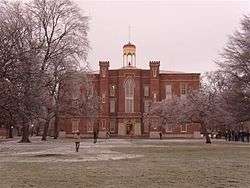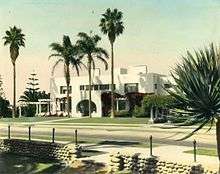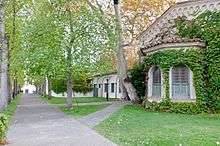Ellen Browning Scripps
| Ellen Browning Scripps | |
|---|---|
 | |
| Born |
October 18, 1836 London, England |
| Died |
August 3, 1932 (aged 95) La Jolla, California |
| Alma mater | Knox College |
| Known for | Philanthropy, Journalism |
| Parent(s) |
James Mogg Scripps Ellen Mary Saunders |
| Relatives |
James E. Scripps, (1835–1906; brother) E. W. Scripps, (1854–1926; half-brother) |
Ellen Browning Scripps (October 18, 1836 – August 3, 1932) was an American journalist and philanthropist who was the founding donor of several major institutions in Southern California. She and her brother E.W. Scripps created America's largest chain of newspapers, linking midwestern industrial cities with booming towns in the west. By the 1920s, Ellen Browning Scripps was worth an estimated $30 million (or $3.5 billion in 2016 dollars), most of which she gave away. She established the Scripps Institution of Oceanography in La Jolla, California, the oldest and largest center for ocean and earth science research. She appeared on the cover of Time magazine after founding Scripps College in Claremont, California.[1] She also donated millions of dollars to organizations, worldwide, that promised to advance democratic principles and women's education. She never married.[2]
Family history
Ellen Browning Scripps was born on October 18, 1836, on South Molton St. in St. George Parish, London. Her father, James Mogg Scripps (1803–73), was the youngest of six children born to London publisher William Armiger Scripps (1772–1851) and Mary Dixie (1771–1838). He was apprenticed to Charles Lewis, the leading bookbinder of London where he learned the trade. James married his cousin Elizabeth Sabey in 1829 and had two children, only one of whom lived to maturity, Elizabeth Mary (1831-1914). Elizabeth Sabey Scripps died the day after the latter's birth. Two years later, James Mogg married Ellen Mary Saunders. They had six children, five of whom lived to adulthood: James E. Scripps (1835-1906), Ellen Browning (1836-1932), William Arminger (1838-1914), George Henry (1839-1900) and John Mogg (1840–63). Ellen Mary Scripps died of breast cancer in 1841.[3]
After the failure of his bookbinding shop and the death of his second wife, James Mogg emigrated to the United States with his six children in April 1844. They headed to Rushville, Illinois, where other members of the Scripps family owned property. James Mogg married his third wife Julia Osborn in November 1844. They had five children: Julia Anne (1847-1898), Thomas Osborn (1848-53), Frederick Tudor (1850-1936), Eliza Virginia (1852-1921), and Edward Wyllis or E.W. Scripps (1854-1926), the well-known newspaper tycoon and founder of The E.W. Scripps Company.[4]
Biography
Early life

Born in London and raised on the Illinois prairie, Ellen Browning Scripps was the only one of her ten siblings to attend college. She studied science and mathematics at Knox College in Galesburg, IL, one of the few educational institutions to admit women, even if it did not yet grant college degrees. She graduated in 1859 with a certificate from the Female Collegiate Department. Afterwards, she returned to Rushville, Illinois, to teach in a one-room schoolhouse.[5]
Newspaper journalist
After the American Civil War, Scripps gave up her job as a schoolteacher and headed to Detroit, at that time a burgeoning industrial center in the West. She joined her brother James E. Scripps in publishing The Detroit Evening News, a short, inexpensive, and politically independent newspaper pitched to the city's working class. This was to be the start of the Scripps family fortune. She wrote a daily column, nicknamed "Miss Ellen's Miscellany," that reduced local and national news to short sound bites. According to Gerald Baldasty, "Her columns of "Miscellany" and other topics became the inspiration for the Newspaper Enterprise Association, a news features service that Edward Scripps established in 1902."[6] In the 1870s and 1880s, the Scripps papers expanded to include The Cleveland Press, The Cincinnati Post, and the St. Louis Chronicle.[3]
A shareholder, Ellen Scripps played an important role in Scripps councils. She gave business advice to her younger brother E.W. and sided with him in family financial disputes. He credited her with saving him from financial ruin in more than one instance.[6] In the 1880s, E.W.'s attempt to seize control of the Scripps Publishing Company failed, resulting in a divisive lawsuit and a break with his brother James.[7]
Travels
In 1881, Ellen and E.W. travelled to Europe so that the latter could take a break from work and recover his health. They took the railroad through France to the Mediterranean Sea, crossed by ship to Algeria, then headed north into Italy, Austria, and Germany. Ellen wrote letters back to The Detroit Evening News about their travels, describing her impressions of people and places.[8] When Ellen returned to her job at the News, she found that she was no longer needed at the copy desk. She began a decade of travel, heading to the American South, New England, Cuba, and Mexico. In 1888-89 she made a second trip to Europe that included a visit to L'Exposition Universelle in Paris and three months in Spain. A decade later, she toured France, Belgium, and England.[3]:76-86
California
In 1887, Ellen's sister Julia Anne moved to Alameda, California, to seek a remedy for crippling rheumatoid arthritis. She found a home at the Remedial Institute and School of Philosophy, one of the many utopian communities founded in the late nineteenth century.[7]:4 Concerned about her sister's welfare, Ellen made her first trip to California in the winter of 1890. Soon afterwards, Ellen and E.W. bought land in San Diego and established Miramar Ranch with their brother Fred. Miramar Ranch encompassed what is now Scripps Ranch, a suburban community, and the Marine Corps Air Station Miramar. The ranch house was torn down in 1973.[9][10]
Ellen lived, on and off, at Miramar until 1897 when she moved into a seaside cottage that she had built in La Jolla. She named it South Molton Villa (sometimes spelled South Moulton Villa) after the street on which she had been born.
Ellen gradually stepped out of her intimate family circle and began to acquire a large set of female acquaintances. La Jolla had a growing number summer and year-round residents, many of whom were unmarried women or widows. She remarked that in the early days, "It was a woman's town."[3]:142 She was a founding member of the La Jolla Woman's Club and became involved in a wide variety of progressive causes. In 1909, she and her sister Virginia helped Joseph H. Johnson, the bishop of the Los Angeles Diocese of the Episcopal Church, to establish The Bishop's School as a preparatory school for girls.[11]

South Molton Villa, located on Prospect St. in La Jolla, was located next to Wisteria Cottage, a bungalow owned by Virginia Scripps. Wisteria Cottage was renovated in 1910 by architect Irving J. Gill a pioneer in the modernist movement. It now serves as the gallery and exhibition space of the La Jolla Historical Society.[12]
After South Molton Villa was destroyed by fire in 1915, Ellen Scripps commissioned Gill to build a new, fireproof concrete structure in the same modern architectural language as The Bishop's School, the La Jolla Woman's Club, and the La Jolla Recreational Center. It has been described as one of Gill's "masterworks."[13] In 1941, Ellen's trustees donated her house to The Art Center, later the Museum of Contemporary Art in La Jolla. The structure was altered beyond recognition. In 1996, a renovation by Robert Venturi and Denise Scott Brown exposed the original facade.[14]

Wealth
Ellen Browning Scripps made a fortune by investing in E.W. Scripps's growing chain of newspapers in the West. In 1894, E.W. formed a partnership with Milton A. McRae who had risen through the ranks to become one of Scripps's top lieutenants. George H. Scripps joined the partnership in 1895. The group managed The Cincinnati Post, The Cleveland Press, The St. Louis Chronicle, The Toledo News-Bee, and the Kansas City Star. They also acquired newspapers in Memphis, Oklahoma City, Evansville, Terre Haute, Columbus, Denver, Dallas, and Houston. In the late 1890s, E.W. began to acquire papers in California, including The Los Angeles Record, The San Diego Sun, and The San Francisco News. In the Pacific Northwest, the growing profitability of working-class newspapers led to the development of The Seattle Star, The Spokane Press, The Tacoma Times, and The Portland News, all pitched to dock workers, miners, lumbermen, and cannery workers.[15] By 1905, E.W. estimated that profits on "my little Western papers" were many times greater than those of his Eastern ones.[16]
George H. Scripps died in 1900, leaving behind a will described as "a legacy of hate." He gave his shares of Evening News stock to E.W., whom James E. Scripps considered his nemesis. Ellen, meanwhile, received George's shares of the Scripps Publishing Co. This led to an eleven-year legal battle that E.W. and Ellen ultimately won.[3]:145
Philanthropy
Interested in science and education, Ellen Browning Scripps donated the bulk of her fortune to the Scripps Institution of Oceanography, The Bishop’s School in La Jolla, and the Scripps College in Claremont, California.[17] She also financed the construction of the La Jolla Women's Club, the La Jolla Recreational Center, Torrey Pines State Natural Reserve, and the La Jolla Children's Pool, and she was an important early supporter of the San Diego Zoo.[5] After a stay in the hospital due to a broken hip, Ellen helped to found the Scripps Memorial Hospital and funded the Scripps Research Clinic. These organizations eventually became The Scripps Research Institute, and two of the core providers now comprising Scripps Health—Scripps Memorial Hospital La Jolla and Scripps Clinic.[5]:p.86 The New York Times estimated that, during her lifetime, she gave gifts and donations to charitable causes that totaled more than $2 million, a conservative estimate equivalent to $35,107,000 in 2016 dollars.[18]
Death
Ellen Browning Scripps died in her La Jolla home on August 3, 1932, a few weeks before her ninety-sixth birthday. Shortly thereafter, the leading newspaper trade journal Editor & Publisher praised her contributions to American journalism: "Many women have contributed, directly and indirectly, to the development of the American press, but none more influentially and beneficently than Ellen Browning Scripps."[6] The New York Times, meanwhile, recognized her as "one of the pioneers in modern American journalism." Her obituary described her as a woman who had perfected "the art of living" as well as the art of giving.[19]
Legacy

Scripps was nominated and inducted into the Women's Hall of Fame in 2007 hosted by the California Museum; Commission on the Status of Women; University of California, San Diego Women's Center; and San Diego State University Women's Studies.

From the 1920s, Scripps was the major benefactor of the San Diego Natural History Museum, financing its building and education programs.[20] In 1933, the Scripps estate donated over 1,000 watercolor paintings of California wildflowers by A. R. Valentien to the San Diego Natural History Museum.[21][22]

The following are institutions she helped to establish or fund:
- Scripps College in Claremont, CA
- Scripps Institution of Oceanography, UC San Diego, est. 1903, formerly known as the Marine Biological Association
- Scripps Research Institute
- Scripps Aquarium, La Jolla (now Birch Aquarium at Scripps)
- The Bishop's School in La Jolla, CA
- Scripps Memorial Hospital
- Scripps Metabolic Clinic
- La Jolla Woman's Club
- Torrey Pines State Reserve
- The Children's Pool, est. 1931
- Donations to
- Pomona College
- Knox College
- Cleveland College and Cleveland Museum of Natural History
- Constantinople Women's College
- San Diego State University (Scripps Cottage)
- City of Rushville, Illinois
- San Diego Museum Association
- The Children's Home, San Diego
- St. James by-the-Sea Episcopal Church, La Jolla
- La Jolla Athenaeum Music & Arts Library
- La Jolla-Riford Branch Library
- San Diego Society of Natural History
- The San Diego Museum of Man's Ancient Egypt exhibit
- San Diego Zoo
- San Diego YMCA and YWCA
- Asilomar Conference Center (YWCA)
- Community Welfare Building
See also
- List of people on the cover of Time Magazine: 1920s - 22 Feb. 1926
References
- ↑ "In California: Miss Ellen Scripps...another Oxford Rises". Time magazine. February 22, 1926.
- ↑ Klenn, Monica. "Ellen Browning Scripps". The Almanac of American Philanthropy. The Philanthropy Roundtable. Retrieved 8 June 2016.
- 1 2 3 4 5 Schaelchlin, Patricia A. (2003). The Newspaper Barons: A Biography of the Scripps Family. San Diego, CA: San Diego Historical Society. ISBN 978-0967007649.
- ↑ Scripps, James E. (1903). A Genealogical History of the Scripps Family and Its Various Alliances. Detroit, MI : Private Circulation. pp. 21–23.
- 1 2 3 Britt, Albert (1960). Ellen Browning Scripps: journalist and idealist. Oxford : Printed for Scripps College at the University Press. p. 19-24.
- 1 2 3 Baldasty, Gerald J. (2000). "Scripps, Ellen Browning" in American National Biography Online. Oxford University Press.
- 1 2 McClain, Molly (Spring 2010). "The Scripps Family's San Diego Experiment". The Journal of San Diego History. The San Diego History Center. 56 (1-2): 1–30. Retrieved 20 August 2016.
- ↑ Scripps College (1973). A Sampling From Travel Letters, 1881-1883. Claremont, CA : Scripps College.
- ↑ Preece, Charles (1990). E.W. and Ellen Browning Scripps: An Unmatched Pair. Chelsea, MD: Bookcrafters. p. 116. ISBN 0-9619349-2-1.
- ↑ "Miramar Ranch (Scripps Castle)". Hidden San Diego. Retrieved 22 August 2016.
- ↑ McClain, Molly (Fall 2008). "The Bishop's School, 1909-2009" (PDF). The Journal of San Diego History. 54 (4): 235–267. Retrieved 21 August 2016.
- ↑ Crane, Heather. "Wisteria Cottage Rehabilitation and Historic Structure Report". IS Architecture, Ione R. Stiegler FAIA. Retrieved 21 August 2016.
- ↑ Hines, Thomas S. (2000). Irving Gill and the Architecture of Reform. New York: The Monicelli Press. p. 179. ISBN 978-1580930161.
- ↑ Harper, Hilliard (May 5, 1988). "La Jolla Museum of Art Unveils Venturi's Design for Expansion". The Los Angeles Times. Retrieved 21 August 2016.
- ↑ "E.W. Scripps Company History". Retrieved August 21, 2016.
- ↑ Baldasty, Gerald J.; Jordan, Myron K. (1993). "Scripps' Competitive Strategy: The Art of Non-Competition". Journalism Quarterly. American Association of Schools and Departments of Journalism. 70 (2): 265–75. doi:10.1177/1077699016659075.
- ↑ The Philanthropy Hall of Fame, Ellen Browning Scripps
- ↑ "MISS ELLEN SCRIPPS DIES AT AGE OF 95". The New York Times. August 4, 1932. Retrieved 12 February 2016.
- ↑ "A Modern Mid-Victorian", The New York Times, August 5, 1932
- ↑ Engstrand, Iris; Bullard, Anne (1999). Inspired by Nature: The San Diego Natural History Museum after 125 years. San Diego: San Diego Natural History Museum. pp. 64–65. ISBN 0918969042.
- ↑ Kamerling, Bruce (Summer 1978). "Anna and Albert Valentien: The Arts and Crafts Movement in San Diego". Journal of San Diego History. 24 (3): 343–65.
- ↑ Dykens, Margaret N. (2003). Plant portraits: the California Legacy of A.R. Valentien. Irvine, Calif.: Irvine Museum. ISBN 0971409250.
Further reading
- Molly McClain, Ellen Browning Scripps: New Money and American Philanthropy (University of Nebraska Press, 2017)
- Molly McClain, "The La Jolla of Ellen Browning Scripps," The Journal of San Diego History 57, no. 4 (2011)
- Bruce Kamerling, "How Ellen Scripps Brought Ancient Egypt to San Diego", The Journal of San Diego History 38, no. 2 (1992)
- Elizabeth N. Shor, "How Scripps Institution Came To San Diego," The Journal of San Diego History 27, no. 3 (Summer 1981)
- Ellen Browning Scripps, in Carl Heilbron, History of San Diego (San Diego: San Diego Press Club, 1936), pp. 92–94
- "In California," Time magazine, February 22, 1926
External links
- https://ellenbrowningscripps.com
- Ellen Browning Scripps — Scripps Health.
- E.W. Scripps Papers, Mahn Center for Archives & Special Collections, Ohio University Libraries, Athens, Ohio. — Manuscript collection, primarily correspondence.
- Ellen Browning Scripps Collection, Ella Strong Denison Library, Scripps College, Claremont, CA. — Manuscript collection, primarily correspondence.
- Museum of Contemporary Art San Diego — on the site of her residence in La Jolla.
.jpg)